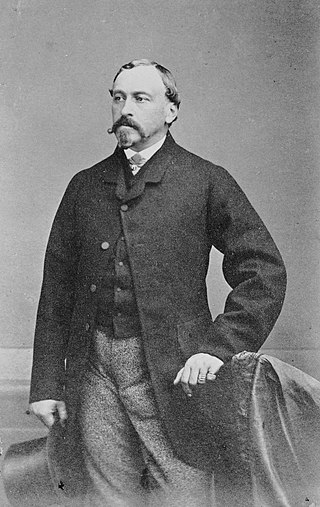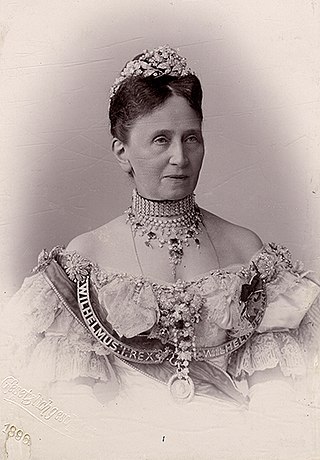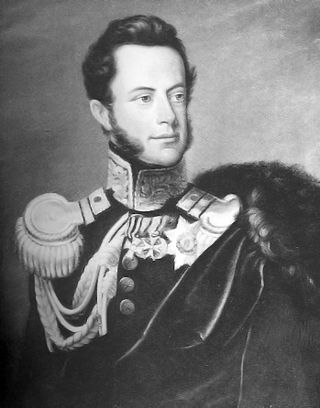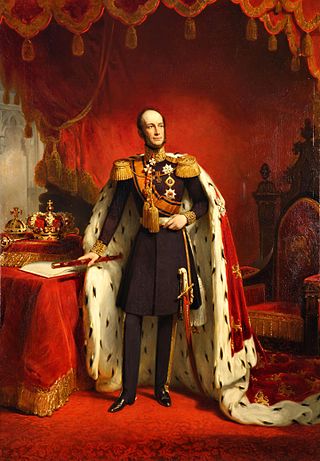
Anna Pavlovna of Russia was Queen of the Netherlands by marriage to King William II of the Netherlands. She was a Russian patriot who upheld a strict royal etiquette in the Netherlands, where she never felt at home, and identified more as an Imperial Russian grand duchess than a Dutch queen. She had no political influence, but was active within charity.

Prince Edward, Duke of Kent and Strathearn, was the fourth son and fifth child of King George III and Queen Charlotte. His only child, Victoria, became Queen of the United Kingdom 17 years after his death.

Prince Augustus Frederick, Duke of Sussex, was the sixth son and ninth child of King George III and his queen consort, Charlotte of Mecklenburg-Strelitz. He was the only surviving son of George III who did not pursue an army or navy career. A Whig, he was known for his liberal views, which included reform of Parliament, abolition of the slave trade, Catholic Emancipation, and the removal of existing civil restrictions on Jews and Dissenters.

The Order of St. Andrew the Apostle the First-Called is the highest order conferred by both the Russian Imperial Family and by the Russian Federation . Established as the first and highest order of chivalry of the Russian Tsardom and the Russian Empire in 1698, it was removed from the honours system under the USSR before being re-established as the top Russian civil and military order in 1998.

Ernest II was Duke of Saxe-Coburg and Gotha from 29 January 1844 to his death in 1893. He was born in Coburg to Ernest III, Duke of Saxe-Coburg-Saalfeld, and Princess Louise of Saxe-Gotha-Altenburg. His father became Duke of Saxe-Coburg and Gotha in 1826 through an exchange of territories.

Louise of Prussia was Grand Duchess of Baden from 1856 to 1907 as the wife of Grand Duke Frederick I. Princess Louise was the second child and only daughter of Wilhelm I, German Emperor, and Augusta of Saxe-Weimar-Eisenach. She was the younger sister of Frederick William ("Fritz"), the future German Emperor Frederick III, and aunt of Emperor Wilhelm II.

Saxe-Coburg-Saalfeld was one of the Saxon Duchies held by the Ernestine line of the Wettin Dynasty. Established in 1699, the Saxe-Coburg-Saalfield line lasted until the reshuffle of the Ernestine territories that occurred following the extinction of the Saxe-Gotha line in 1825, in which the Saxe-Coburg-Saalfeld line received Gotha, but lost Saalfeld to Saxe-Meiningen.

Princess Marie Luise Alexandrina of Saxe-Weimar-Eisenach was a princess of Saxe-Weimar-Eisenach, by birth, and, by marriage, a princess of Prussia. She was the daughter of Charles Frederick, Grand Duke of Saxe-Weimar-Eisenach and Grand Duchess Maria Pavlovna of Russia.

Wilhelm was joint sovereign Duke of Nassau, along with his father's cousin Frederick Augustus, reigning from 1816 until 1839. He was also sovereign Prince of Nassau-Weilburg from 1816 until its incorporation into the duchy of Nassau.
The Highland Society of London is a charity registered in England and Wales, with "the view of establishing and supporting schools in the Highlands and in the Northern parts of Great Britain, for relieving distressed Highlanders at a distance from their native homes, for preserving the antiquities and rescuing from oblivion the valuable remains of Celtic literature, and for promoting the improvement and general welfare of the Northern parts of Great Britain".

William II was King of the Netherlands, Grand Duke of Luxembourg, and Duke of Limburg.

Princess Agnes of Anhalt-Dessau was the eldest daughter of Leopold IV, Duke of Anhalt by his wife Princess Frederica of Prussia. She was a member of the House of Ascania, and by her marriage to Ernst I, Duke of Saxe-Altenburg, Duchess consort of Saxe-Altenburg.

The House Order of Albert the Bear was founded in 1836 as a joint House Order by three dukes of Anhalt from separate branches of the family: Henry, Duke of Anhalt-Köthen, Leopold IV, Duke of Anhalt-Dessau, and Alexander Karl, Duke of Anhalt-Bernburg.
Events in the year 1910 in Germany.
Events in the year 1898 in Germany.
Events from the year 1880 in Germany.
Events in the year 1906 in Germany.
Events in the year 1877 in Germany.
Events in the year 1887 in Germany.

The House Order of Henry the Lion In German: Hausorden Heinrichs des Löwen, was the House Order of the Duchy of Brunswick. It was instituted by William VIII, Duke of Brunswick on 25 April 1834. The ribbon of the Order was red with yellow edges. It had five grades: Grand Cross, Grand Commander with Sash, Commander, Knight 1st Class, Knight 2nd Class, plus Medal of Merit for Science and Arts, the Cross of Merit and the Medal of Honour. The Order was named in honour of Henry the Lion, who remains a popular figure to this day.














